Bin x 2 - problem with ISIS
-
Peter Velez
- Posts: 146
- Joined: Tue May 12, 2020 7:36 am
Re: Bin x 2 - problem with ISIS
David
thanks for your considered response.
On the slit and sampling - if I am binning x2 35 microns shouldn't be too much - but I can easily switch back to 23 microns. I agree that unbinned 19 microns is the best option.
We have been plagued with high humidity and clouds of late so I have not had much opportunity to play with this too much. However, I did get the chance to take some calibration frames when the roof was open last night and so have some taken at ambient 6.5 - 8C.
Slant - I can measure it manually with ISIS and know roughly what it should be. However, with some calibration frames it adjusts automatically to an odd result - I know my slant is around 0.12 degrees. With some calibration images it jumps to 3 or 4 degrees negative. If there were an option to turn off the automatic slant and tilt measurement I could be more accurate with calibration - I suspect exposure length and focussing are to blame.
Camera alignment - I'm in good shape there with slant of about 0.12 and tilt of about -0.17. I might refine it but its definitely at the margins.
.lst file - this is a mystery. I have tried to calibrate with a variety of calibration images taken at different temperatures last night. I adjusted the x-pixel for 5944 as well. The RMS using the .lst file fails to achieve a reasonable match - even when using the same lines as you have suggested. So for example, I achieved RMS of 12.8 using the same .lst file. However, refining that with the Calibration Assistant and setting the Ha wavelength I achieve an RMS of 0.22. It is very odd.
What I find especially strange is that the .lst process works fine when I use unbinned images.
I'll tweak the focus when the conditions are right next ie when its a cold afternoon and see what happens
Pete
thanks for your considered response.
On the slit and sampling - if I am binning x2 35 microns shouldn't be too much - but I can easily switch back to 23 microns. I agree that unbinned 19 microns is the best option.
We have been plagued with high humidity and clouds of late so I have not had much opportunity to play with this too much. However, I did get the chance to take some calibration frames when the roof was open last night and so have some taken at ambient 6.5 - 8C.
Slant - I can measure it manually with ISIS and know roughly what it should be. However, with some calibration frames it adjusts automatically to an odd result - I know my slant is around 0.12 degrees. With some calibration images it jumps to 3 or 4 degrees negative. If there were an option to turn off the automatic slant and tilt measurement I could be more accurate with calibration - I suspect exposure length and focussing are to blame.
Camera alignment - I'm in good shape there with slant of about 0.12 and tilt of about -0.17. I might refine it but its definitely at the margins.
.lst file - this is a mystery. I have tried to calibrate with a variety of calibration images taken at different temperatures last night. I adjusted the x-pixel for 5944 as well. The RMS using the .lst file fails to achieve a reasonable match - even when using the same lines as you have suggested. So for example, I achieved RMS of 12.8 using the same .lst file. However, refining that with the Calibration Assistant and setting the Ha wavelength I achieve an RMS of 0.22. It is very odd.
What I find especially strange is that the .lst process works fine when I use unbinned images.
I'll tweak the focus when the conditions are right next ie when its a cold afternoon and see what happens
Pete
-
Robin Leadbeater
- Posts: 1930
- Joined: Mon Sep 26, 2011 4:41 pm
- Contact:
Re: Bin x 2 - problem with ISIS
Hi PeterPeter Velez wrote:
Slant - I can measure it manually with ISIS and know roughly what it should be. However, with some calibration frames it adjusts automatically to an odd result - I know my slant is around 0.12 degrees. With some calibration images it jumps to 3 or 4 degrees negative. If there were an option to turn off the automatic slant and tilt measurement I could be more accurate with calibration
What is this automatic slant measurement ? I have not seen this before in ISIS. (Is this using the calibration assistant? I don't use that) I just use the measured slant which ISIS automatically enters in the box and it then uses this figure for all data reduction until I tell it otherwise. (see attached screen shot, dont worry about the crazy slant angle in the image it is not real !) The slant measurement is made by drawing a box tightly round a well exposed isolated line near the centre of the field covering the height of the line between the outer sky background limits.
Robin
LHIRES III #29 ATIK314 ALPY 600/200 ATIK428 Star Analyser 100/200 C11 EQ6
http://www.threehillsobservatory.co.uk
http://www.threehillsobservatory.co.uk
-
Peter Velez
- Posts: 146
- Joined: Tue May 12, 2020 7:36 am
Re: Bin x 2 - problem with ISIS
Thanks Robin
yes, it is a feature of the Calibration Assistant so it makes sense that you may not have seen it.
I measure the slant and tilt in the manner you suggest. However, when I run the Calibration Assistant, ISIS seems to measure slant and tilt again, populates the fields on the screen in the way you illustrated and then determines the calibration fit. What I find is that on occasions the slant and tilt automatically filled depart wildly from what I have measured - usually when the calibration fails.
Unfortunately, I rely on Calibration Assistant to refine the calibration. Using either the Predefined mode or a .lst file, I rarely achieve an RMS below 8 (though yesterday a few test calibration frames did work). So I then use Calibration Assistant to tighten up the match. For example, I just calibrated using the .lst file applying the lines David suggested yesterday. I manually set the slant (0.13) and tilt (-0.13) that I measured and achieved an RMS of 3.4. I then ran the Calibration Assistant. It corrected the slant to 0.23 and tilt to 0.01 and achieved an RMS of 0.19.
This is when I have a calibration frame that ISIS likes. Changing to another Ar Ne frame - 10 seconds rather than 20 but taken at the same ambient temp and using the same method, I achieve an RMS of 8.5. I measured the slant and tilt for that data set at 0.08 and -0.08. Running the Calibration Assistant, the slant and tilt are auto corrected to -11.80 and 0.01 respectively. The tilt is acceptable but the slant is way off. As a result, the RMS achieved is only 4.97. Better, but not usable. I attach a screenshot.
I can overcome this by taking multiple Ar Ne frames at different exposure lengths and thereby determine which works. Sometimes longer exposures work better and other times not - probably because my focus is not tight enough. At least I have a handle now on why the calibration may be failing. It would be great if I could achieve a reliable calibration with the .lst file every time - which I can when not binning my images. More work to be done!
Pete
yes, it is a feature of the Calibration Assistant so it makes sense that you may not have seen it.
I measure the slant and tilt in the manner you suggest. However, when I run the Calibration Assistant, ISIS seems to measure slant and tilt again, populates the fields on the screen in the way you illustrated and then determines the calibration fit. What I find is that on occasions the slant and tilt automatically filled depart wildly from what I have measured - usually when the calibration fails.
Unfortunately, I rely on Calibration Assistant to refine the calibration. Using either the Predefined mode or a .lst file, I rarely achieve an RMS below 8 (though yesterday a few test calibration frames did work). So I then use Calibration Assistant to tighten up the match. For example, I just calibrated using the .lst file applying the lines David suggested yesterday. I manually set the slant (0.13) and tilt (-0.13) that I measured and achieved an RMS of 3.4. I then ran the Calibration Assistant. It corrected the slant to 0.23 and tilt to 0.01 and achieved an RMS of 0.19.
This is when I have a calibration frame that ISIS likes. Changing to another Ar Ne frame - 10 seconds rather than 20 but taken at the same ambient temp and using the same method, I achieve an RMS of 8.5. I measured the slant and tilt for that data set at 0.08 and -0.08. Running the Calibration Assistant, the slant and tilt are auto corrected to -11.80 and 0.01 respectively. The tilt is acceptable but the slant is way off. As a result, the RMS achieved is only 4.97. Better, but not usable. I attach a screenshot.
I can overcome this by taking multiple Ar Ne frames at different exposure lengths and thereby determine which works. Sometimes longer exposures work better and other times not - probably because my focus is not tight enough. At least I have a handle now on why the calibration may be failing. It would be great if I could achieve a reliable calibration with the .lst file every time - which I can when not binning my images. More work to be done!
Pete
-
Christian Buil
- Posts: 1431
- Joined: Mon Sep 26, 2011 6:59 pm
- Contact:
Re: Bin x 2 - problem with ISIS
Peter,
First, remember that the ISIS assistant tool for spectral calibration uses a mixed method: an A0 star + a neon lamp. Your internal lamp is a RELCO type (Argon-neon starter) and therefore, the assistant cannot be used.
Second, the sharpness of your lines is not excellent in the ultraviolet (this is a classic problem, and that is why I developed UVEX ). It is quite difficult to calibrate with this type of image (but not impossible of course, see below ...) - here your image:
). It is quite difficult to calibrate with this type of image (but not impossible of course, see below ...) - here your image:
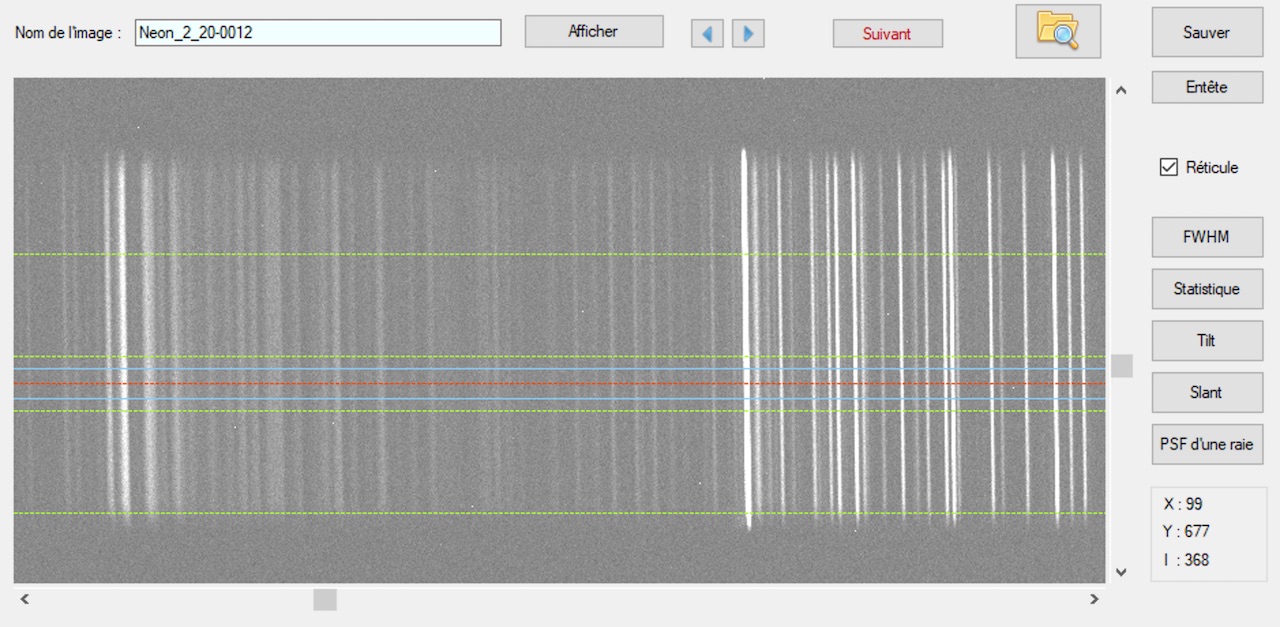
The problem is not the slit width but the spectrograph chromatism (adjust the focus for the UV lines).
My recommendation for this type of situation is to perform a preliminary calibration using the Balmer lines of a A type star. Are you familiar with this?
For example, I used the image of the star you provided me to extract the following raw profile (before I removed the sky background with the command L_SKY and I extracted the spectral profile with L_ADD):
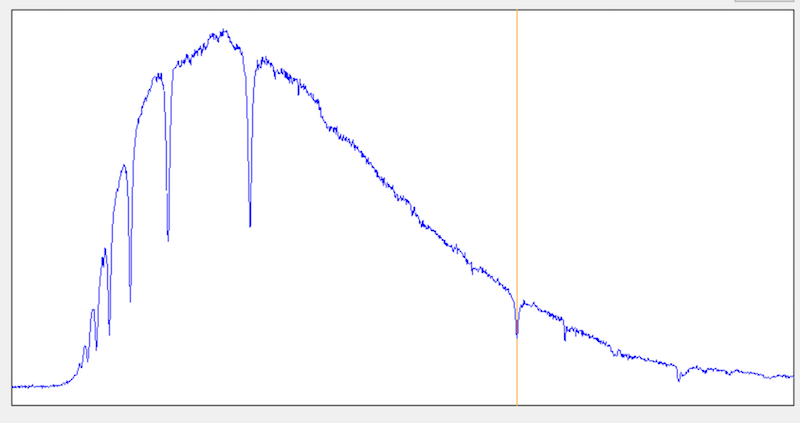
(I your situation and a manual procedure :
L_SKY star_image star_sky_removed 440 485 520 560
L_ADD star_sky_removed raw_profile 485 520 )
For a maximal precision, remove the continuum (optional):
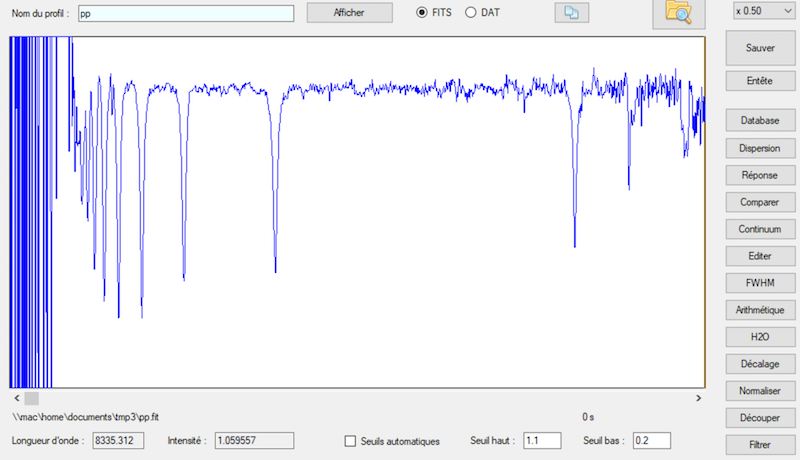
And here, the calibration law find:
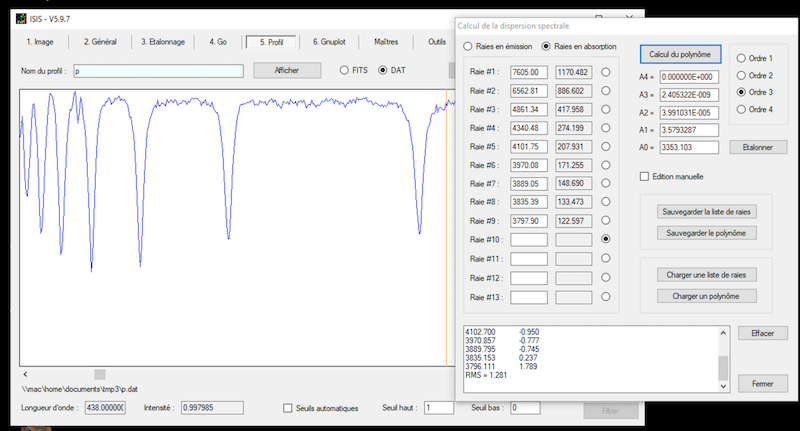
Note the RMS error of 1.3 A, which is quite correct. Do not try to use order 4 in your situation, because extrapolation is dangerous. Limit yourself to order 3.
It is interesting to calculate the linear calibration function (order 1):
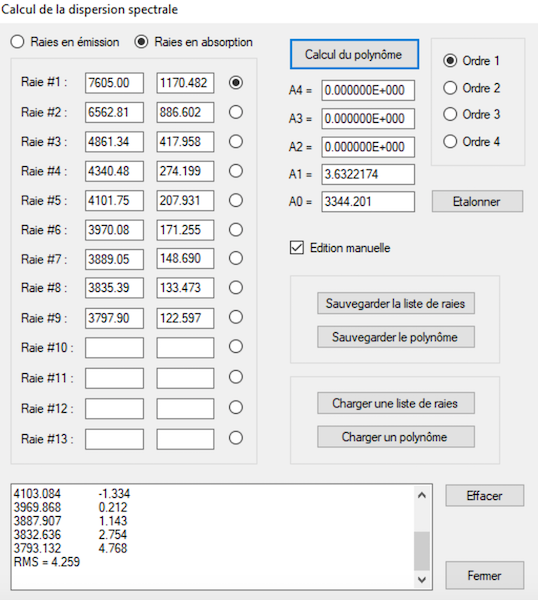
... for your spectrograph, the typical dispersion is 3.63 A/pixel. Now you can build an .lst file from an atlas of the RELCO lamp using this average dispersion:
3
3.63
...
...
...
...
5849.07
4200.67
4158.59
Note that in your current spectrum the only well-contrasted and unblanded lines in the UV are the argon lines 4158.59 and 4200.67 A.
Christian Buil
First, remember that the ISIS assistant tool for spectral calibration uses a mixed method: an A0 star + a neon lamp. Your internal lamp is a RELCO type (Argon-neon starter) and therefore, the assistant cannot be used.
Second, the sharpness of your lines is not excellent in the ultraviolet (this is a classic problem, and that is why I developed UVEX

The problem is not the slit width but the spectrograph chromatism (adjust the focus for the UV lines).
My recommendation for this type of situation is to perform a preliminary calibration using the Balmer lines of a A type star. Are you familiar with this?
For example, I used the image of the star you provided me to extract the following raw profile (before I removed the sky background with the command L_SKY and I extracted the spectral profile with L_ADD):

(I your situation and a manual procedure :
L_SKY star_image star_sky_removed 440 485 520 560
L_ADD star_sky_removed raw_profile 485 520 )
For a maximal precision, remove the continuum (optional):

And here, the calibration law find:

Note the RMS error of 1.3 A, which is quite correct. Do not try to use order 4 in your situation, because extrapolation is dangerous. Limit yourself to order 3.
It is interesting to calculate the linear calibration function (order 1):

... for your spectrograph, the typical dispersion is 3.63 A/pixel. Now you can build an .lst file from an atlas of the RELCO lamp using this average dispersion:
3
3.63
...
...
...
...
5849.07
4200.67
4158.59
Note that in your current spectrum the only well-contrasted and unblanded lines in the UV are the argon lines 4158.59 and 4200.67 A.
Christian Buil
-
Peter Velez
- Posts: 146
- Joined: Tue May 12, 2020 7:36 am
Re: Bin x 2 - problem with ISIS
Thanks Christian
there is much to digest here. I hadn't appreciated that the Ar Ne lamp couldn't be used with the Calibration Assistant.
I will have a tinker with your suggested approach and see how that goes.
Pete
there is much to digest here. I hadn't appreciated that the Ar Ne lamp couldn't be used with the Calibration Assistant.
I will have a tinker with your suggested approach and see how that goes.
Pete
-
Peter Velez
- Posts: 146
- Joined: Tue May 12, 2020 7:36 am
Re: Bin x 2 - problem with ISIS
Christian
Thanks again for your lengthy response.
I have a few questions and then some comments/responses.
First the questions:
1. When reinstalling my LISA recently, I changed over the bulb in the calibration unit from a Ne bulb to the Ar Ne bulb that Shelyak supplies. As result, I cannot use either the Predefined Mode nor the Calibration Assistant to calibrate my images. Is that correct?
2. I managed to follow the Command line process you outlined but not the step to remove the continuum. Can you please explain how you managed that in ISIS or point me to a webpage that explains how to do this. Your tutorial pages are excellent but I can't see anywhere where this process is discussed.
Responses/comments
Using the method you outlined, I developed a .lst file with only a few lines in the UV/blue. Making sure that the slant is correctly configured and using the x-pixel for the 6416 line instead of 5944, I can calibrate reasonably well on my latest data set with an RMS of about 1.2. Is there a way to improve this - other than to improve my focus?
Trying this approach on some data from last week, its much more hit and miss - I've had RMS of about 12. Using an older .lst file, I achieved an RMS of 0.2!
I will refine my focus to get a more balanced position and see how that goes.
Pete
Thanks again for your lengthy response.
I have a few questions and then some comments/responses.
First the questions:
1. When reinstalling my LISA recently, I changed over the bulb in the calibration unit from a Ne bulb to the Ar Ne bulb that Shelyak supplies. As result, I cannot use either the Predefined Mode nor the Calibration Assistant to calibrate my images. Is that correct?
2. I managed to follow the Command line process you outlined but not the step to remove the continuum. Can you please explain how you managed that in ISIS or point me to a webpage that explains how to do this. Your tutorial pages are excellent but I can't see anywhere where this process is discussed.
Responses/comments
Using the method you outlined, I developed a .lst file with only a few lines in the UV/blue. Making sure that the slant is correctly configured and using the x-pixel for the 6416 line instead of 5944, I can calibrate reasonably well on my latest data set with an RMS of about 1.2. Is there a way to improve this - other than to improve my focus?
Trying this approach on some data from last week, its much more hit and miss - I've had RMS of about 12. Using an older .lst file, I achieved an RMS of 0.2!
I will refine my focus to get a more balanced position and see how that goes.
Pete
-
etienne bertrand
- Posts: 1040
- Joined: Mon Aug 31, 2015 11:26 am
Re: Bin x 2 - problem with ISIS
Possible the neon is to low in exposure ? maybe more exposure and add 2 or 3 neon for better signal/noise ?
-
Christian Buil
- Posts: 1431
- Joined: Mon Sep 26, 2011 6:59 pm
- Contact:
Re: Bin x 2 - problem with ISIS
Peter,
Question 1 :
You have just, unfortunately, changing the lamp makes it very difficult to use automatic tools. In the red part of the spectrum, the very intense argon lines mix with the faint neon lines, and this causes errors and confusion. In the blue, the argon lines of the RELCO lamp are very low intense and very blended if you use a LISA/Alpy spectrograph. It also makes the exploitation of these lines difficult, your experience is proof. You've probably understood, I don't really like the spectrum of this RELCO lamp (and the spectrum aspect change which the time and the lamp...). I very rarely use this source to calibrate my spectra ! We should in fact avoid using the name "neon lamp" with this model, but the name "ArNe lamp", this would avoid confusion. You are not responsible for this at all, everyone makes the same mistake.
Question 2 :
For remove continuum use the "Continuum" tools (Profile tab). It is an important ISIS tool to know, but it is true that it is poorly documented.
You have to double click before then after a detail that you want to remove (the most intense Balmer lines for example). See an application in the middle of this page:
http://www.astrosurf.com/buil/UVEX_soft/
(I will try to improve the documentation!)
Be careful with the evaluation of the slant angle (the procedure is manual with the slant button). Here an example with your data:
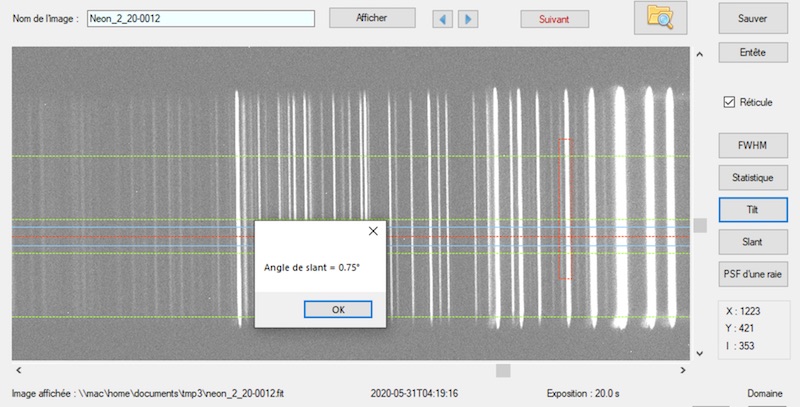
An RMS error of 1.2 A is a correct result by using LISA. Can you give your actual .lst file for analyse ?
Christian
Question 1 :
You have just, unfortunately, changing the lamp makes it very difficult to use automatic tools. In the red part of the spectrum, the very intense argon lines mix with the faint neon lines, and this causes errors and confusion. In the blue, the argon lines of the RELCO lamp are very low intense and very blended if you use a LISA/Alpy spectrograph. It also makes the exploitation of these lines difficult, your experience is proof. You've probably understood, I don't really like the spectrum of this RELCO lamp (and the spectrum aspect change which the time and the lamp...). I very rarely use this source to calibrate my spectra ! We should in fact avoid using the name "neon lamp" with this model, but the name "ArNe lamp", this would avoid confusion. You are not responsible for this at all, everyone makes the same mistake.
Question 2 :
For remove continuum use the "Continuum" tools (Profile tab). It is an important ISIS tool to know, but it is true that it is poorly documented.
You have to double click before then after a detail that you want to remove (the most intense Balmer lines for example). See an application in the middle of this page:
http://www.astrosurf.com/buil/UVEX_soft/
(I will try to improve the documentation!)
Be careful with the evaluation of the slant angle (the procedure is manual with the slant button). Here an example with your data:

An RMS error of 1.2 A is a correct result by using LISA. Can you give your actual .lst file for analyse ?
Christian
-
Peter Velez
- Posts: 146
- Joined: Tue May 12, 2020 7:36 am
Re: Bin x 2 - problem with ISIS
Thanks Christian
On the Ar Ne lamp - I could change back to the standard Ne lamp for the LISA. I would only do so if the automatic tools will yield me a better calibration. If I understand your earlier email, I can use the Calibration Assistant with the old Ne lamp. Does calibration with that method improve the fit as it introduces the Ha line as an extra data point? I do recall reading on your website that this method and the .lst file method generate similar results - if that is the case, I will continue with the .lst method and Ar Ne lamp.
On continuum removal - like so many others, I am grateful that you have shared ISIS as freeware. So I have no issue with documentation. I will experiment with the tool and post any additional queries.
On slant measurement - I am quite comfortable with this method. It does yield different results depending on which line I use but generally they are close anyway. The only issue I had was that the Calibration Assistant seems to have an automatic measurement function - if the calibration frame is not sharp, the tool changes the slant from what I have measured. If I am no longer using the Assistant, this is no longer an issue for me.
On the .lst file - I have had several versions that I have trialled. I have attached 2 - one labelled "better" and the other "alternate". The "better" file is one I prepared yesterday based on your last post. This has been the best alternative for me. The "alternative" file is one that I developed based on the file that seemed to work very well for unbinned images. I simply removed all lines that were wildly out when processing spectra. It is not as consistent as your list but sometimes generates a very good result.
On a target RMS - if 1.2 is the best I can reasonably expect from the LISA, then I know what to aim for and will stop trying to refine it. But if others can achieve better, I am very keen to pursue that
Pete
On the Ar Ne lamp - I could change back to the standard Ne lamp for the LISA. I would only do so if the automatic tools will yield me a better calibration. If I understand your earlier email, I can use the Calibration Assistant with the old Ne lamp. Does calibration with that method improve the fit as it introduces the Ha line as an extra data point? I do recall reading on your website that this method and the .lst file method generate similar results - if that is the case, I will continue with the .lst method and Ar Ne lamp.
On continuum removal - like so many others, I am grateful that you have shared ISIS as freeware. So I have no issue with documentation. I will experiment with the tool and post any additional queries.
On slant measurement - I am quite comfortable with this method. It does yield different results depending on which line I use but generally they are close anyway. The only issue I had was that the Calibration Assistant seems to have an automatic measurement function - if the calibration frame is not sharp, the tool changes the slant from what I have measured. If I am no longer using the Assistant, this is no longer an issue for me.
On the .lst file - I have had several versions that I have trialled. I have attached 2 - one labelled "better" and the other "alternate". The "better" file is one I prepared yesterday based on your last post. This has been the best alternative for me. The "alternative" file is one that I developed based on the file that seemed to work very well for unbinned images. I simply removed all lines that were wildly out when processing spectra. It is not as consistent as your list but sometimes generates a very good result.
On a target RMS - if 1.2 is the best I can reasonably expect from the LISA, then I know what to aim for and will stop trying to refine it. But if others can achieve better, I am very keen to pursue that
Pete
- Attachments
-
- LISA_2_alternate.zip
- (414 Bytes) Downloaded 284 times
-
Benjamin Mauclaire
- Posts: 258
- Joined: Thu Sep 29, 2011 10:14 am
Re: Bin x 2 - problem with ISIS
Hi Pete,
Can you join the *** raw 2D spectrum *** of your Relco calibration lamp in bin 2x2 in order to be able to help you?
The file needed has to be unprocessed!
Benji
Can you join the *** raw 2D spectrum *** of your Relco calibration lamp in bin 2x2 in order to be able to help you?
The file needed has to be unprocessed!
Benji
Spcaudace spectroscopy software: saving you hundred hours of frustration.